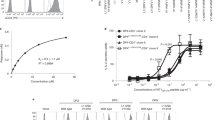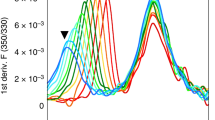Abstract
A complex between HLA-DR3 and a fragment of invariant chain called CLIP was isolated from a human cell line defective in antigen presentation and its X-ray crystal structure determined. Previous data indicate that this complex is an intermediate in class II histocompatibility maturation, occurring between invariant chain–DR3 and antigenic peptide–DR3 complexes. The structure shows that the CLIP fragment binds to DR3 in a way almost identical to that in which antigenic peptides bind class II histocompatibility gly cop rote ins. The structure is the substrate for the loading of antigenic peptides by an exchange process catalysed by DM.
This is a preview of subscription content, access via your institution
Access options
Subscribe to this journal
Receive 51 print issues and online access
$199.00 per year
only $3.90 per issue
Buy this article
- Purchase on SpringerLink
- Instant access to full article PDF
Prices may be subject to local taxes which are calculated during checkout
Similar content being viewed by others
References
Cresswell, P. A. Rev. Immun. 12, 259–293 (1994).
Riberdy, J. M., Newcomb, J. R., Surman, M. J., Barbosa, J. A. & Cresswell, P. Nature 360, 474–477 (1992).
Sette, A. et al. Science 258, 1801–1804 (1992).
Mellins, E. et al. J. exp. Med. 179, 541–549 (1994).
Monji, T., McCormack, A. L., Yates, J. R. & Pious, D. J. exp. Med. 153, 4468–4477 (1994).
Avva, R. & Cresswell, P. Immunity 1, 763–774 (1994).
Xu, M., Capraro, G. A., Daibata, M., Reyes, V. E. & Humphreys, R. E. Molec. Immun. 31, 723–731 (1994).
Freisewinkel, I. M., Schenck, K. & Koch, N. Proc. natn. Acad. Sci. U.S.A. 90, 9703–9706 (1993).
Romagnoli, P. & Germain, R. N. J. exp. Med. 180, 1107–1113 (1994).
Bijlmakers, M. E., Benaroch, P. & Ploegh, H. L. J. exp. Med. 180, 623–629 (1994).
Malcherek, G., Gnau, V., Jung, G., Rammensee, H.-G. & Melms, A. J. exp. Med. 181, 527–536 (1995).
Sette, A., Southwood, S., Miller, J. & Apella, E. J. exp. Med. 181, 677–683 (1995).
Geluk, A., van Meijgaarden, K. E., Drijfhout, J. W. & Ottenhof, T. H. M. Molec. Immun. 32, 975–981 (1995).
Gautam, A. N., Pearson, C., Quinn, V., McDevitt, H. O. & Milburn, P. J. Proc. natn. Acad. Sci. U.S.A. 92, 335–339 (1995).
Kropshofer, H., Vogt, A. B. & Hämmerling, G. J. Proc. natn. Acad. Sci. U.S.A. 92, 8313–8317 (1995).
Morris, P. et al. Nature 368, 551–554 (1994).
Fling, S. P., Arp, B. & Pious, D. Nature 368, 554–558 (1994).
Sloan, V. S. et al. Nature 375, 802–806 (1995).
Denzin, L. K. & Cresswell, P. Cell 82, 155–165 (1995).
Sherman, M. A., Weber, D. A. & Jensen, P. E. Immunity 3, 197–205 (1995).
Mellins, E. et al. Nature 343, 71–74 (1990).
Stern, L. J. et al. Nature 368, 215–221 (1994).
Brown, J. H. et al. Nature 368, 33–39 (1993).
Jardetzky, T. S. et al. Nature 368, 711–718 (1994).
Kim, J., Urban, R. G., Strominger, J. L. & Wiley, D. C. Science 266, 1870–1874 (1994).
Urban, R. G., Chicz, R. M. & Strominger, J. L. J. exp. Med. 180, 751–755 (1994).
Malcherek, G. et al. Int. Immun. 5, 1229–1237 (1993).
Geluk, A. et al. J. Immun. 152, 5742–5748 (1994).
Stern, L. J. & Wiley, D. C. Cell 68, 465–477 (1992).
Germain, R. N. & Rinker, A. G. Nature 363, 725–728 (1993).
Morkowski, S. et al. J. exp. Med. 182, 1403–1413 (1995).
Jasanoff, A., Park, S.-J. & Wiley, D. C. Proc. natn. Acad. Sci. U.S.A. 92, 9900–9904 (1995).
Park, S.-J., Sadegh-Nasseri, S. & Wiley, D. C. Proc. natn. Acad. Sci. U.S.A. 92, 11289–11293 (1995).
Lee, C. & McConnell, H. Proc. natn. Acad. Sci. U.S.A. 92, 8269–8273 (1995).
Chicz, R. M. et al. Nature 358, 764–768 (1992).
Chicz, R. M. et al. J. exp. Med. 178, 27–47 (1993).
Tulp, A., Verwoerd, D., Dobberstein, B., Ploegh, H. L. & Pieters, J. Nature 369, 120–126 (1994).
Nelson, C. A., Petzold, S. J. & Unanue, E. R. Nature 371, 250–252 (1994).
Maurer, D. & Gorski, J. J. Immun. 146, 621–626 (1991).
Gorga, J. C., Horejsi, V., Johnson, D. R., Raghupathy, R. & Strominger, J. L. J. biol. Chem. 262, 16087–16094 (1987).
Gorga, J. C., Brown, J. H., Jardetzky, T., Wiley, D. C. & Strominger, J. L. Res. Immun. 142, 401–407 (1991).
Collaborative Computational Project, N. Acta crystallogr. D50, 760–763 (1994).
Navaza, J. Acta crystallogr. A50, 157–163 (1994).
Brünger, A. T. Nature 355, 472–475 (1992).
Jones, T. A., Zou, J.-Y., Cowan, S. W. & Kjeldgaard, M. Acta crystallogr. A47, 110–119 (1991).
Luzzati, V. Acta crystallogr. 5, 802–810 (1952).
Huang, C. C., Petterson, E. F., Klein, T. E., Ferrin, T. E. & Langridge, R. J. molec. Graphics 9, 230–236 (1991).
Nicholls, A., Sharp, K. A. & Honig, B. Proteins 11, 281–296 (1991).
Kabsch, W. Acta crystallogr. A34, 827–828 (1978).
Madden, D. R., Gorga, J. C., Strominger, J. L. & Wiley, D. C. Cell 70, 1035–1048 (1992).
Author information
Authors and Affiliations
Rights and permissions
About this article
Cite this article
Ghosh, P., Amaya, M., Mellins, E. et al. The structure of an intermediate in class II MHC maturation: CLIP bound to HLA-DR3. Nature 378, 457–462 (1995). https://doi.org/10.1038/378457a0
Received:
Accepted:
Issue Date:
DOI: https://doi.org/10.1038/378457a0
This article is cited by
-
MHC-II dynamics are maintained in HLA-DR allotypes to ensure catalyzed peptide exchange
Nature Chemical Biology (2023)
-
The transmembrane domain and luminal C-terminal region independently support invariant chain trimerization and assembly with MHCII into nonamers
BMC Immunology (2021)
-
Critical amino acid variations in HLA-DQB1* molecules confers susceptibility to Autoimmune Thyroid Disease in south India
Genes & Immunity (2019)
-
Interactions of HLA-DR and Topoisomerase I Epitope Modulated Genetic Risk for Systemic Sclerosis
Scientific Reports (2019)
-
Ancient features of the MHC class II presentation pathway, and a model for the possible origin of MHC molecules
Immunogenetics (2019)



